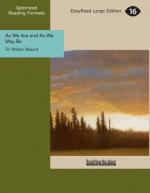St. Nicolas Cole Abbey is, within, a kind of gilded drawing-room. There is gilt everywhere, gilt and wood-carving; and on Sunday morning, thanks to the strange taste of the Vicar, who likes to dress himself up in scarlet and green, and to have a boy making a smell with a swinging pot, there are sometimes more than the customary ten for a congregation.
Of St. Mary Somerset only the tower remains. Why they pulled down this church, why they pulled down St. Michael’s Queenhithe, or St. Nicolas Olave, or St. Mary Magdalen, all in this part of London, passeth man’s understanding. If you want to find out what these churches were like, you may consult the book by Britton and Le Keux on London Churches. They are represented in a collection of steel engravings drawn after the fashion of eighty years ago, so as to bring out the strong points with great softening of unpleasant details.
Many of the churches were not rebuilt after the Fire. This shows that by the year 1666 this part of London was already beginning to be occupied more by warehouses than by private dwellings. Among them were St. Andrew Hubberd, St. Benet Sherehog, St. Leonard, Eastcheap, All Hallows the Less, Holy Trinity, St. Martin Vintry, St. Laurence Poultney, St. Botolph Billingsgate, St. Thomas Apostle, St. Mary Mounthaut, St. Peter’s, St. Gregory’s by St Paul, and St. Anne’s Blackfriars—thirteen in all.
At St. Benet’s Church—where Fielding was married—you may now hear the service in the Welsh language, just as in Wellclose Square you may hear it in Swedish. In Endell Street, Holborn, you may hear it in French, and in Palestine Place, Hackney, you may hear it in Hebrew.
Certain spaces on old maps of London are coloured green to show where stood certain churchyards. In Thames Street the churchyard of All Hallows the Less still stands; in Queen Street that of St. Thomas Apostle, in Laurence Poultney Hill that of St. Laurence Poultney, a very large and well-kept churchyard; St. Dunstan’s, All Hallows, Barking, St. Stephen’s, Wallbrook all keep their churchyards still. That of St. Anne’s, Blackfriars, stands retired behind the houses. But those of St. Nicolas Cole Abbey, St. Mary Somerset, St. Botolph’s, and St. Mary Magdalen, formerly large and crowded churchyards, still kept sacred in the year 1720, and, indeed, until further interments were forbidden in the year 1845, are now quite built over and forgotten. What has become of the churchyards of St. Michael Royal, St. Michael Queenhithe, St. Benet, St. George, St. Leonard Eastcheap, and St. James’s Garlickhithe? Alas! no one knows. The tombstones are taken away, the ground has been dug up, the coffin-wood burned, the bones dispersed, and of all the thousands, the tens of thousands, of citizens buried there—old and young, rich and poor, Lord Mayors, aldermen, merchants, clerks, craftsmen, and servants—the dust of all is scattered abroad, the names of all are as much forgotten as if they never lived. But they have lived, and if you seek their monument—look around. It is in the greatness, the wealth, the dignity of the modern City, that these ancient citizens live again. Life is a long united chain with links that cannot be separated; the story of humanity is unbroken; it will go on continuous and continued until the Creator’s great purpose is fulfilled, and the drama of Man complete.




